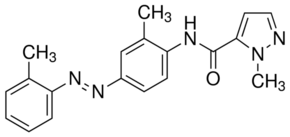All AbMole products are for research use only, cannot be used for human consumption.

CH-223191 is a potent and specific aryl hydrocarbon receptor (AhR) antagonist. CH-223191 inhibits TCDD-mediated nuclear translocation and DNA binding of AhR, and inhibits TCDD-induced luciferase activity with an IC50 of 0.03 μM.
*The compound is unstable in solutions, freshly prepared is recommended

Gut Microbes. 2024 May 5;16(1):2347722.
Microbiota-derived I3A protects the intestine against radiation injury by activating AhR/IL-10/Wnt signaling and enhancing the abundance of probiotics
CH-223191 purchased from AbMole

Int Immunopharmacol. 2024 Feb;129:111637.
Fraxin (7-hydroxy-6-methoxycoumarin 8-glucoside) confers protection against ionizing radiation-induced intestinal epithelial injury in vitro and in vivo
CH-223191 purchased from AbMole

Cell Death Dis. 2023 Feb 8;14(2):92.
Aryl hydrocarbon receptor dependent anti-inflammation and neuroprotective effects of tryptophan metabolites on retinal ischemia/reperfusion injury
CH-223191 purchased from AbMole

J Immunol. 2023 Nov 29;ji2300090.
The Microbial Tryptophan Metabolite Contributes to the Remission of Salmonella typhimurium Infection in Mice
CH-223191 purchased from AbMole

Chemosphere. 2022 Nov;307(Pt 2):135962.
Fine particulate matter induces heart defects via AHR/ROS-mediated endoplasmic reticulum stress
CH-223191 purchased from AbMole

Advances in Clinical Medicine. 13(3), 4166-4175.
The Regulation of Aryl Hydrocarbon Receptor (AhR) in Dry Eye
CH-223191 purchased from AbMole
| Cell Experiment | |
|---|---|
| Cell lines | BV-2 murine microglia cell |
| Preparation method | The BV-2 murine microglia cell line grown in DMEM medium with 4.5 g/L D-Glutamine, 10 % FCS and 1 % penicillin/streptomycin in standard environment. Cells were starved 24 hours before the following experiments. For protein phosphorylation detection, subcellular fractionation and immunocytochemistry assay, ITE (1 μM) was added for 4 h following with LPS (100 ng/ml) for next 4 h. For quantitative RT-PCR and western blot of inflammation cytokines, ITE (1 μM) was added for 4 hours following with LPS (100 ng/ml) for next 20 hours. CH223191 (10 μM) was pre-treated for 24 h before ITE treatment if needed. |
| Concentrations | 10 μM |
| Incubation time | 24 h |
| Animal Experiment | |
|---|---|
| Animal models | Male ICR mice (6 weeks old) |
| Formulation | 10 mg/kg in corn oil |
| Dosages | 10 mg/kg once a day for 25 days |
| Administration | oral |
| Molecular Weight | 333.39 |
| Formula | C19H19N5O |
| CAS Number | 301326-22-7 |
| Solubility (25°C) | DMSO ≥ 30 mg/mL |
| Storage |
Powder -20°C 3 years ; 4°C 2 years In solvent -80°C 6 months ; -20°C 1 month |
[2] Kuo-Liang Wei, et al. Sorafenib is an antagonist of the aryl hydrocarbon receptor
[5] Lizath M Aguiniga, et al. Acyloxyacyl hydrolase regulates voiding activity
| Related Aryl hydrocarbon Receptor Products |
|---|
| AHR antagonist 5
AHR antagonist 5, a potent and orally active aryl hydrocarbon receptor (AHR) antagonist, has an IC50 of < 0.5 µΜ. |
| AHR antagonist 5 free base
AHR antagonist 5 free base is a selective and orally active aryl hydrocarbon receptor (AHR) inhibitor. |
| KYN-101
KYN-101 is a potent, selective and orally active AHR inhibitor. |
| AHR agonist 4
AHR agonist 4 is an agonist of Aryl hydrocarbon receptor (AHR), assocaited with the immune balance of Th17/22 and Treg cells. |
| Benzyl butyl phthalate
Benzyl butyl phthalate can trigger the migration and invasion of hemangioma (HA) cells via upregulation of Zeb1. Benzyl butyl phthalate activates aryl hydrocarbon receptor (AhR) in breast cancer cells to stimulate SPHK1/S1P/S1PR3 signaling and enhances formation of metastasis-initiating breast cancer stem cells (BCSCs). |
All AbMole products are for research use only, cannot be used for human consumption or veterinary use. We do not provide products or services to individuals. Please comply with the intended use and do not use AbMole products for any other purpose.


Products are for research use only. Not for human use. We do not sell to patients.
© Copyright 2010-2024 AbMole BioScience. All Rights Reserved.
